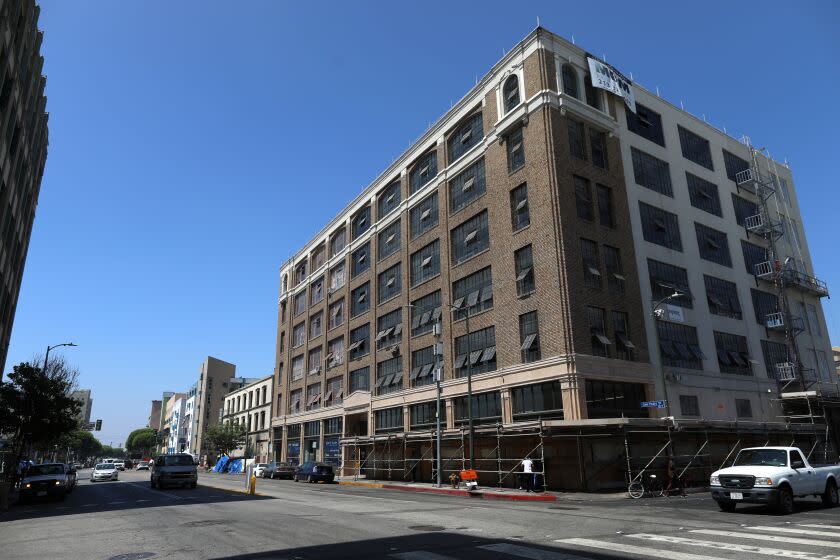Editorial: Let skid row have affordable and market-rate housing. It's the forward-looking thing to do

For more than a century, skid row has been a community of last resort. In the early 20th century, it was the area, on the east side of downtown, where the railroad ended, depositing immigrants and men seeking better work. With little money in hand they stayed in hotels, flophouses and religious missions. Some never found the success they sought and simply stayed on skid row, sometimes falling into the grasp of addictions.
Over time, skid row became the part of the city that tolerated those unwanted elsewhere — the addicted, the poor, Black people. The housing stock, mostly of single-room occupancy hotels, was cheap, but about half of it was demolished from the mid-1960s to the mid-1970s when owners decided they would rather tear their buildings down than make city-ordered repairs. In the 1970s the city adopted an official policy of "containment" — concentrating cheap hotels, shelters and service agencies on skid row to both take care of residents and prevent them from setting up in other parts of downtown or the city. It was born of a desire by leaders to help and also to wipe their hands of the misery there.
In the last few decades, as homelessness has hit crisis levels, L.A. leaders have sought to build homeless housing throughout the city and take some pressure off skid row, where sidewalks are covered in tents and people cram their belongings into bags and shopping carts. An appalling lack of public toilets forces people to use streets as bathrooms. A federal judge ordered the city to essentially shelter the entirety of skid row. His order was eventually overturned. But skid row remains the community in Los Angeles with the highest concentration of homeless people — 4,402 by the 2022 homeless count. The people who live on skid row — both housed and unhoused — have grown to see themselves as a community, even trying (unsuccessfully) to establish a neighborhood council in an effort to make elected officials see them as residents, not a collection of the downtrodden.
Now, skid row stands at a turning point. The new Downtown Community Plan — also known as DTLA 2040 because it would set the rules for development for the next 20 years — would designate a portion of historic skid row, between 5th and 7th streets and San Pedro Street and Central Avenue, as an area where only affordable housing could be built. The area, which will get a new zoning designation, IX1, meaning mixed industrial use, is a sliver of skid row. Still, it's significant because it would be the first area of the city with new housing reserved for residents defined as acutely low income (homeless or almost) to moderately low income.
Some skid row residents and advocates for homeless people say this affordable-housing-only district will ensure poor people aren't displaced by the market-rate development that will otherwise transform the community. Critics, including some service providers, however, warn that the city will be creating Containment 2.0, continuing the economic and social segregation that has fueled the miserable conditions on skid row.
The concerns are justified on both sides. Market-rate projects are already underway at the edges of skid row, and there have been building booms nearby in the Arts District and historic core that pushed out low-income tenants. Yet having any neighborhood officially designated for low-income people is akin to at least economic if not racial segregation. (About 30% of the county's homeless population is Black and 45% is Latino.) A healthy community has a mix of housing — market rate and affordable — and a mix of residents and, according to some, the amenities that generally follow an influx of people with various income levels: supermarkets, hair salons, pharmacies. Those are amenities that skid row has been missing.
But simply declaring there should be a mix of housing won’t make it a reality. How do you allow entry to market-rate developers without displacing thousands of poor people in that community who are either unstably housed or not housed at all?
We believe there is a way to mix both.
The downtown plan already requires housing built anywhere downtown (outside the special IX1 zone) to have a baseline percentage of affordable housing. If a project wants more benefits — like building more densely — the project must offer more affordable housing.
In the skid row zone, city planners could require that market-rate developers provide a greater percentage of affordable units than what is required in the rest of downtown. Or the city could set a cap on the number of market-rate units that could be built in the zone. Developers of 100% affordable housing should still be able to build without restrictions.
The goal in this particularly impoverished community is to make room for more housing and more investment to lift up the neighborhood. Making skid row more of a mixed-income community need not displace current residents or services, if done carefully. Pushing residents out and forcing them to look for another place to live would be a failure. There's room to create a sound community plan that doesn't allow that to happen.
This story originally appeared in Los Angeles Times.

